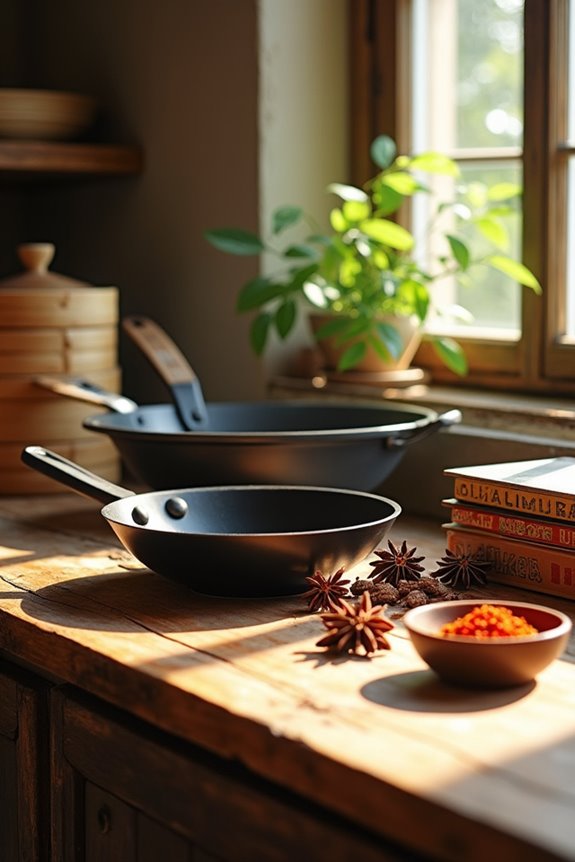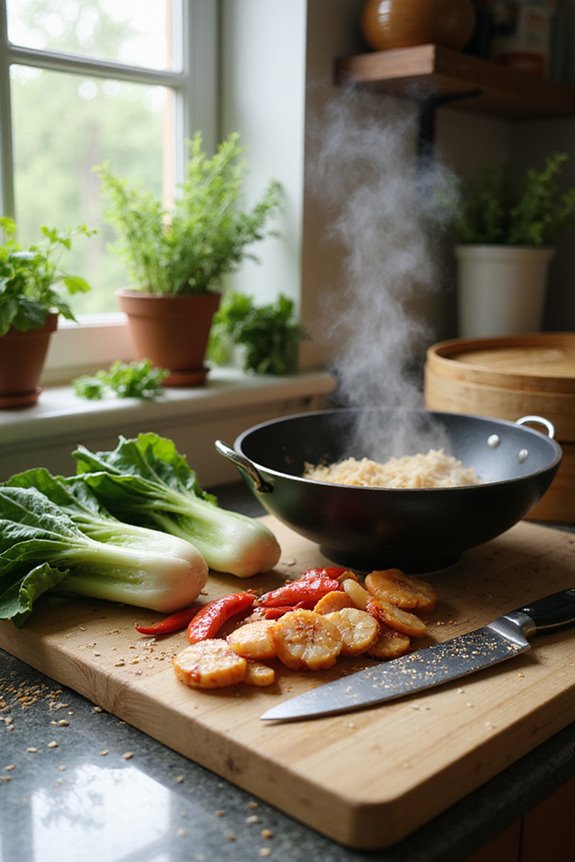As an Amazon Associate, we earn from qualifying purchases. Some links may be affiliate links at no extra cost to you. Although our opinions are based on curated research, we haven't used these products. Articles generated with AI.

3 Best Sustainable Home Materials for Eco-Friendly Living
For eco-friendly living, consider using reclaimed wood, which not only adds unique charm but also reduces waste. Fiber cement is another excellent choice due to its durability and low maintenance needs, lasting over 50 years. Finally, opt for recycled metal, as it’s highly sustainable and can be reused for various applications. These materials enhance energy efficiency and indoor air quality, ultimately benefiting your home. Stick around to discover more sustainable options and insights for your home renovation.
Key Takeaways
- Reclaimed Wood: Offers durability and unique aesthetics while reducing deforestation and landfill waste by repurposing existing materials.
- Fiber Cement: Highly durable with a lifespan over 50 years, it minimizes resource consumption and maintenance costs.
- Sustainable Insulation: Materials with high R-values improve energy efficiency, lower utility bills, and ensure better indoor air quality.
- Recycled Metals: High recycling rates reduce resource extraction and waste, making them a smart choice for sustainable construction.
- Natural Stone: Offers longevity and visual appeal while being sourced locally to minimize transportation emissions.
Our Kindred Home: Herbal Recipes and Plant Wisdom
Sale
Our Kindred Home: Herbal Recipes, Plant Wisdom, and Seasonal Rituals for Rekindling Connection with...
- Hardcover Book
- Morgan, Alyson (Author)
- English (Publication Language)
If you’re someone who appreciates the harmony of nature within your home, “Our Kindred Home: Herbal Recipes and Plant Wisdom” will be an invaluable addition to your library. This beautifully illustrated book invites you to explore herbal preparations organized by season, offering recipes for every plant. You’ll find its relatable narrative addresses modern anxieties about environmental issues. With easy reference sections, accessing information on herbal remedies becomes a breeze. The combination of herbal recipes, women’s empowerment, and ancestral healing not only connects you to nature but also deepens your understanding of caring for the earth in a practical way.
Best For: Anyone seeking to deepen their connection with nature and explore the therapeutic benefits of herbal recipes.
Pros:
- Beautifully illustrated, making it a stunning addition to any coffee table or bookshelf.
- Offers easily accessible herbal preparation guides and recipes, organized seasonally for convenience.
- Encourages personal healing, women’s empowerment, and awareness of environmental issues, providing a multifaceted approach to wellness.
Cons:
- Some readers may find the narrative style less straightforward compared to traditional cookbooks.
- The focus on seasonal herbs and ingredients might limit accessibility depending on location and availability.
- Newcomers to herbalism may feel overwhelmed by the variety of recipes and preparations presented.
Inground Farm Composter for Garden Beds & Home Use
Inground Farm Composter, Outdoor Worm Compost Bin for Garden Beds & Home Use,110/160 Hole,...
- 🐛 Convenient Inground Worm Composter: Bury this worm composter underground or in your garden bed for hassle-free composting. Perfect for eco-conscious families who...
- 🐛 Sturdy and Long-Lasting: Made from long-lasting PVC material, this outdoor farm compost bin is built to withstand the emergency situation. Available in two compact...
- 🐛 Easy to Use: No complex assembly required! Just dig a hole, place the bin, and start composting. Features a removable lid and 360° ventilation holes for a safe,...
The Inground Farm Composter stands out as an essential tool for eco-conscious families and gardening enthusiasts enthusiastic about turning organic waste into nutrient-rich compost. This convenient composting solution, either buried underground or placed in garden beds, transforms kitchen scraps, paper, and leaves in just 2-3 months. Made from durable PVC, it’s sturdy and designed to last. With no complex assembly required, you simply dig a hole, place the bin, and start composting. The dual-bin system allows you to recycle waste year-round, making it perfect for beginners keen to enhance their sustainable gardening practices with minimal hassle.
Best For: Eco-conscious families and gardening newbies looking for an easy way to compost organic waste.
Pros:
- Convenient design: Can be buried underground or placed in garden beds for easy access.
- Durable material: Made from sturdy PVC, ensuring long-lasting use.
- Easy to use: Requires no complex assembly and features a dual-bin system for continuous composting.
Cons:
- Limited capacity: The 2-gallon size may not be sufficient for larger households or gardens.
- Not portable: Once buried, the composter cannot be easily moved.
- Requires time: Composting process takes 2-3 months, which may not appeal to those seeking instant results.
The Natural Building Companion: A Comprehensive Guide to Integrative Design and Construction
The Natural Building Companion: A Comprehensive Guide to Integrative Design and Construction...
- Used Book in Good Condition
- Racusin, Jacob Deva (Author)
- English (Publication Language)
Natural building enthusiasts and environmentally conscious homeowners will find “The Natural Building Companion” an invaluable resource for integrative design and construction. This extensive guide offers detailed insights into methods like strawbale wall systems, insulation choices, and natural plasters. Whether you’re a seasoned builder or a first-time DIYer, you’ll appreciate the clear explanations and practical advice throughout the book. Plus, the included DVD provides visual demonstrations, enhancing your understanding. Users rave about its thoroughness, although some mention challenges in maneuvering chapters. Overall, this book is a must-have for anyone keen to embrace eco-friendly construction techniques while building their dream home.
Best For: Natural building enthusiasts, environmentally conscious homeowners, and both experienced builders and first-time DIYers seeking eco-friendly construction guidance.
Pros:
- Comprehensive coverage of various natural building methods, including strawbale wall systems and insulation choices.
- Clear explanations and practical advice, making it accessible for all skill levels.
- Includes a DVD with visual demonstrations, enhancing understanding of construction techniques.
Cons:
- Some users report difficulties navigating chapters due to the absence of chapter listings at the top of each page.
- A few users mentioned not receiving the DVD despite it being a significant asset.
- May be overwhelming due to the extensive amount of information covered.
Factors to Consider When Choosing Sustainable Home Materials

When choosing sustainable home materials, you’ll want to contemplate several key factors. Look at how long materials last, their environmental impact, and if they’re sourced locally, since local options often reduce transportation emissions. Don’t forget to assess their recyclability and energy efficiency to guarantee your choices support a sustainable future.
Material Longevity and Durability
Selecting sustainable home materials hinges on their longevity and durability, which play a crucial role in reducing resource consumption. When you consider materials like reclaimed wood or stone, their strength and resistance to decay give them a longer lifespan, making them ideal for eco-friendliness. High-durability options, such as fiber cement or metal roofing, can last over 50 years, enhancing long-term sustainability. It’s wise to invest in materials that resist environmental challenges like rot, pests, and weathering, as this can cut down on maintenance costs. Additionally, choosing materials that can be recycled or repurposed at the end of their life cycle not only boosts durability but also aligns with waste-reduction practices, ensuring your home’s impact remains light on the planet.
Environmental Impact Assessment
Understanding the long-term impact of your material choices plays a significant role in building a sustainable home. Start by evaluating the life cycle of materials; consider extraction, production, transportation, use, and disposal. This assessment helps you grasp the overall ecological footprint. Look closely at the carbon footprint; sustainable materials typically emit fewer greenhouse gases than conventional ones. Also, think about resource depletion; prioritize renewable resources that won’t run out for future generations. Water usage matters too; choose materials that need less water for production and usage to conserve local water resources. Finally, evaluate toxicity, ensuring materials don’t release harmful chemicals that could endanger health during any stage of their life cycle. Make informed choices for a healthier future.
Local Sourcing Considerations
Local sourcing isn’t just about the materials; it’s a strategic choice that impacts your entire building project. By choosing locally sourced sustainable materials, you notably reduce transportation emissions, thereby lowering your carbon footprint. Plus, you’ll support the regional economy, keeping funds in the community and promoting resilience. Materials from your local environment usually need less energy for processing, which helps diminish overall environmental impact. Furthermore, local sourcing can enhance your home’s aesthetic, reflecting the unique characteristics and cultural heritage of your area. You’ll also benefit from engaging with local suppliers and artisans, fostering relationships that can drive innovation in sustainable building practices while encouraging responsible consumption and collaboration.
Recyclability and Reusability
When you consider sustainability in home construction, recyclability and reusability should play key roles in your material choices. Recyclability refers to a material’s ability to be transformed into new products, reducing waste and conserving resources. You’ll find that metals and glass have high recycling rates, while some plastics struggle due to contamination or lack of facilities. Similarly, reusable materials like reclaimed wood or bricks can notably lower your environmental impact, minimizing the need for new resources and decreasing landfill waste. By incorporating recyclable and reusable materials into your home design, not only do you support sustainability, but you can also enjoy cost savings on materials and waste disposal. It’s a practical approach to building with the planet in mind.
Energy Efficiency Ratings
Energy efficiency ratings are essential indicators that help you choose sustainable home materials effectively. Look for products with the Energy Star label, which guarantees they meet strict guidelines from the EPA, reducing energy use and utility bills. The Home Energy Rating System (HERS) Index scores homes from 0 to 150, where lower scores represent better efficiency. When selecting insulation, opt for materials with high R-values; for colder climates, an R-value around 30 is recommended for walls. Examine energy-efficient windows too; U-factor ratings below 0.30 signify better heat retention. Finally, incorporating renewable energy sources like solar panels can boost your home’s overall energy efficiency rating, making your eco-friendly home even more sustainable.
Health and Safety Standards
Choosing sustainable home materials involves more than just aesthetics or cost; it’s crucial to prioritize health and safety standards that protect you and your family. When selecting materials, be certain they comply with EPA guidelines for indoor air quality to reduce exposure to harmful chemicals. Look for certifications like Greenguard and LEED, which confirm low emissions of volatile organic compounds (VOCs). Be vigilant about hazardous substances such as formaldehyde and asbestos, as they can pose serious health risks. Additionally, consider fire safety regulations, confirming materials are flame resistant and don’t emit toxic fumes when heated. Understanding a material’s life cycle, from sourcing to disposal, can aid in choosing options that are healthier for both you and the environment.
Cost vs. Benefit Analysis
While considering sustainable home materials often brings to mind higher upfront costs, it’s essential to evaluate the long-term benefits that can make these investments worthwhile. Sustainable materials often lead to lower energy bills and reduced maintenance, ultimately saving you money. Improved indoor air quality and a reduced environmental footprint add value beyond monetary costs. Additionally, government incentives can help offset initial expenses, making these options more financially attractive. Life cycle assessments show that durable and recyclable materials enhance overall cost-effectiveness. Finally, investing in sustainable materials can increase your property value, appealing to buyers who prioritize eco-friendly living. Balancing costs and benefits guarantees your choices reflect both financial sense and a commitment to sustainability.
Aesthetic and Design Appeal
When it comes to sustainable home materials, integrating aesthetic appeal can transform your living space into a stylish haven that reflects your values. Natural textures and colors create a warm atmosphere, connecting you to the outdoors. Materials like reclaimed wood and natural stone boast unique visual characteristics that enhance your home’s character while being eco-friendly. Consider incorporating biophilic design principles, which highlight natural elements, to boost your well-being and create a harmonious environment. Also, sustainably sourced materials often feature artisanal craftsmanship, giving your home one-of-a-kind details that stand out. By choosing these materials, you align your home’s design with modern trends in eco-friendly living, ensuring it looks great and embodies values of environmental stewardship and wellness.
Frequently Asked Questions
What Are the Most Affordable Sustainable Materials for Home Construction?
When you’re considering affordable sustainable materials for home construction, think about bamboo, reclaimed wood, or recycled steel. Bamboo grows quickly, making it a cost-effective option, while reclaimed wood adds character and often saves on expenses. Recycled steel is durable and can be sourced at lower prices than new metal. Each material contributes to eco-friendliness, so you can build a budget-friendly home that’s also kind to the planet. Choosing wisely makes a real difference.
How Do I Find Local Suppliers of Eco-Friendly Building Materials?
To find local suppliers of eco-friendly building materials, start by searching online directories or visiting green building websites. You can also ask at local hardware stores or specialty shops that focus on sustainable products. Check community boards and social media groups for recommendations. Networking with contractors and builders in your area may reveal useful connections. Don’t hesitate to reach out to suppliers and inquire about their eco-friendly options.
Are There Any Certifications for Sustainable Building Materials?
Yes, there are certifications for sustainable building materials you should know about. Look for labels like Forest Stewardship Council (FSC), Greenguard, or Cradle to Cradle Certified. These certifications indicate that materials meet specific environmental standards, ensuring their sustainability. When you’re shopping for these products, this will guide you in choosing responsibly sourced options that contribute positively to the environment while offering quality and durability. Always check for these certifications to make informed choices.
What Are the Health Benefits of Using Sustainable Home Materials?
Using sustainable home materials can considerably boost your indoor air quality. These materials often contain fewer harmful chemicals, reducing your exposure to VOCs and other pollutants. Natural options, like bamboo and reclaimed wood, promote a healthier living environment. Plus, they often provide better insulation, which can enhance your comfort and lower energy costs. Choosing sustainable materials isn’t just good for the planet; it helps create a safer and more enjoyable space for you and your family.
Can Sustainable Materials Withstand Harsh Weather Conditions?
You’ll find that sustainable materials often stand strong against harsh weather conditions. Materials like bamboo and reclaimed wood resist moisture, while steel and recycled aluminum withstand wind and temperature fluctuations. Natural insulation, such as wool and hemp, regulates indoor climates effectively. These options not only protect your home but also lower energy costs and promote healthier living environments. So, when you choose wisely, you’re investing in durability and sustainability for years to come.







